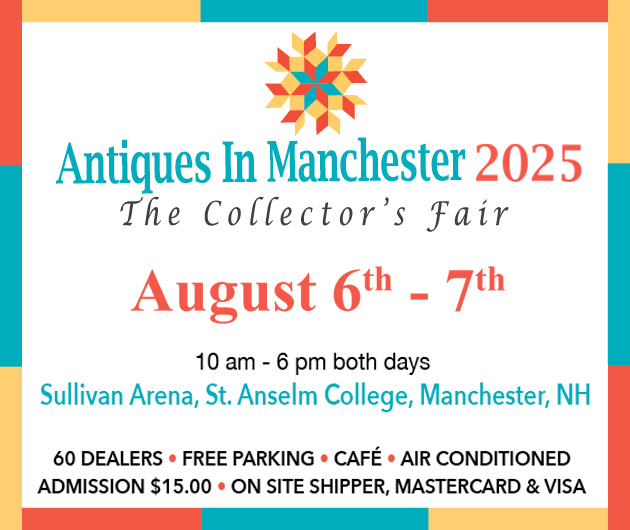Scherenschnitte to Shipwrecks: The Annual Ellsworth Antiques Show
August 14th, 2013
|
The impressive silkwork and oil painting, featuring a velvet hull and silk sails, by Thomas Willis in 1909 was in great condition and considered one of his best examples. It was priced at $12,500. The 1930’s New England gilded fish weathervane was $6400, and the painted New England faux tiger maple Chippendale chest, with three smaller drawers over four and with high bracket feet, dated 1790, was $7500, all from Diana H. Bittel of Bryn Mawr, Pennsylvania.
This is a rare cutout picture (scherenschnitte) of the U.S.S. North Carolina. One of the finest examples of this genre, it was featured on the cover of The Magazine Antiques, February 1952. It’s most likely by Lt. Beekman V. Hoffman (1789-1834), who served as a lieutenant of the U.S.S. Constitution. This picture was purchased from Harry Shaw Newman on August 4, 1950. In its original gold leaf frame, it was 19½" x 23½" and priced at $27,500 by Diana H. Bittel.
An 1860 American carved and polychrome officer’s chart chest, this has an eagle with banner and shield, two sea serpents, and multiple stars. The brass handles and inlaid brass stars are unique to the piece. Measuring 38" x 11" x 13", it was $8500 from James and Nancy Glazer American Antiques, Bailey Island, Maine.
An 1860 American carved and polychrome officer’s chart chest, this has an eagle with banner and shield, two sea serpents, and multiple stars. The brass handles and inlaid brass stars are unique to the piece. Measuring 38" x 11" x 13", it was $8500 from James and Nancy Glazer American Antiques, Bailey Island, Maine.
This 63" x 40" x 15" Gustav Stickley oak china cabinet with arched sides and in excellent original condition was $12,500 from Michael Hingston Antiques. On top is a 1906 Van Briggle vase with stylized relief dandelions and an overall green glaze for $2395.
This rare 1765-70 German parquetry and marquetry inlaid bombé miniature secretary in two parts, 31" x 18" x 9½", with a fully fitted interior, walnut and kingwood, some restoration on veneers, was $2500 from George Subkoff Antiques. |
Ellsworth, Maine
In its eighth year at Woodlawn, the Ellsworth (Maine) Antiques Show is not only a first-class shopping destination for collectors, dealers, and antiques enthusiasts; it also serves a charitable cause by benefitting the educational programs of the Woodlawn Museum, Gardens & Park.
The Woodlawn estate, consisting of a large Federal and Greek Revival main house and carriage barn, was built by Colonel John Black between 1824 and 1827. The estate was willed to the Hancock County Trustees of Public Reservations in 1928 by George Nixon Black Jr., the last member of the three generations of the family to occupy Woodlawn. The property has been maintained for public use since 1929.
The tented outdoor Ellsworth Antiques Show, held on the sprawling 180-acre estate of pastoral meadows and elegant gardens on August 14-17, is billed as America’s longest-running summer antiques show. Since 2006, when the show moved from its original location at Ellsworth City Hall, the three-day event, which includes a benefit cocktail party, dinner, and show preview, has grossed over $130,000 for school programs, lectures, and workshops held at Woodlawn.
Joshua Torrance, executive director of Woodlawn Museum, Gardens & Park, stated in the show’s press release, “The show not only brings together beautiful artifacts of American and Native American history, it also helps to raise funds to continue important programs for students at Woodlawn and has a significant economic impact that directly benefits our local communities.”
Though the combination of antiques show and charitable event is not unheard of, it is quite nice to see the venue of such an event directly benefit in a quid pro quo fashion. The historic estate, with its collection of European and American furniture, portraits, and miniatures, mid-19th-century carpeting, books, and a wide variety of china and glassware, not only complements the show, it also provides a picturesque location. Visitors also have the option to purchase a ticket to tour the house while they are attending the show, with the proceeds helping keep the museum an active part of Maine’s cultural heritage.
The show features 27 dealers. There’s a preview cocktail party on the evening before the show, which prides itself on its high-end museum-quality items available at a wide price range. There was no question of the quality of the items I chanced upon. They were indeed spectacular. Prices ranged from the low hundreds into tens of thousands of dollars. In addition to the range in prices, there was a varied selection of exquisite and unusual items available—from Grenfell Mission hooked mats to a chair with a Micmac quilled birch bark back and an exceptionally large 19th-century table swift.
Ellsworth is along Maine’s coastal route, so nautically themed items were certainly prevalent. Several dealers offered some rare gems. For instance, Pennsylvania dealer Diana H. Bittel had a rare scherenschnitte (cut paper picture) of the U.S.S. North Carolina for $27,500. The magnificent black-and-white cutout, depicting the naval ship in the company of two other ships (dwarfed by her size) with an intricately cut decorative border, is thought to be the work of Lt. Beekman V. Hoffman (1789-1834). Hoffman, who served as a lieutenant on the U.S.S. Constitution, made a similar picture of the Constitution. Though the picture of the North Carolina is not signed, calligraphy examples on the reverse paper backing prove that it was done by the same hand. Bittel had also extensive documentation of the artwork’s provenance including a copy of the cover of The Magazine Antiques from February 1952, which featured the cut-paper piece in a retro colorized version in a red and blue color palette.
Connecticut dealers Hanes & Ruskin offered an excellent watercolor and gouache painting of the Orono, which had local ties. The Orono was built in the nearby town of Bucksport, Maine, in 1851. The title of the painting is Barque “Orono” of Ellsworth Entering the Port of Marseilles and it is dated 1852. It is signed by Joseph Honoré Pellegrin (French, 1793-1869), considered one of the best Mediterranean port painters of the 19th century. The inscription on the black bar beneath the image reads, “Barque Orono, C. Chase, Master, Entering the Port of Marseilles, Jan’y 7th 1852.” The picture probably records the first Atlantic crossing of the Orono and was priced at $3750.
Hanes & Ruskin also offered an unusually large 19th-century table swift that was in working order. Lee Hanes stated that it was the largest table swift he had ever come across and he had never seen another one like it. This beautifully carved rare item was priced at $1500.
The Ellsworth Antiques Show was not short of remarkable and rare objects. I discovered an incredible collection of pen and ink schoolgirl drawings at the booth of southern Maine dealers DeWolfe and Wood Rare Books. The extensive collection of early drawings was done by Rebecca, Clarisse, Eliza, and Sally Fowler and some other family members of Danvers, Massachusetts, between 1816 and 1850. It is remarkable that these drawings have remained together. It was the goal of the dealers to keep the entire collection intact; they would not sell pieces individually, and the whole lot was priced at $8500.
Another marvelous item that caught my eye was a Jones, Ball & Co. coin silver presentation water pitcher with grapevine decoration with the inscription, “Presented to/ Rev. Dr. & Mrs. Henry Smith/ as a token of/ Friendship & Esteem/ by a few Ladies of/ Marietta/ 1855.” It was $3250. Though New Hampshire dealer Michael Hingston assured me that these types of water pitchers were commonly given as gifts, he said it was less common to come across one with its inscription still intact, stating that most people had inscriptions removed later on.
To accompany the pitcher, Hingston provided a short biography of the recipient of this magnificent vessel. Rev. Henry Smith was born in Milton, Vermont, in 1805, graduated from Middlebury College in 1827, and then received his theological degree from Andover Theological Seminary in Andover, Massachusetts. In 1832 he moved to Marietta, Ohio, and helped establish Marietta College, initially known as the Marietta Collegiate Institute and Western Teachers’ Seminary. He was appointed as the first “professor of the languages” at the college in 1833 and married Hannah Bates that same year. In 1846, he was appointed as the second president of Marietta College and served until 1855, when he accepted a position at Lane Theological Seminary in Walnut Hills, Ohio. Hannah Bates was the daughter of Rev. Joshua Bates and Anna Poor Bates. Rev. Joshua Bates was president of Middlebury College between 1818 and 1839.
The Ellsworth Antiques Show at Woodlawn proved to be an outstanding venue, ripe with history and intrigue—from the objects in the show to the museum’s collection, everything seemed to have a story.
For more information about Woodlawn, visit the Web site (www.woodlawn museum.com).
|
|
|
|
|
|
Originally published in the November 2013 issue of Maine Antique Digest. © 2013 Maine Antique Digest

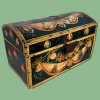


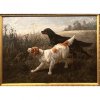

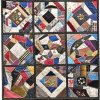















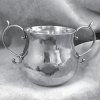

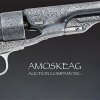

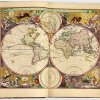




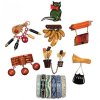


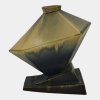






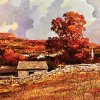



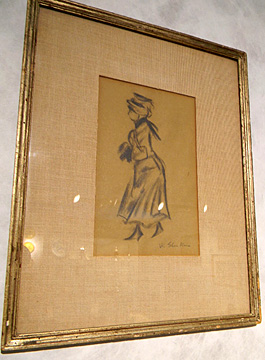
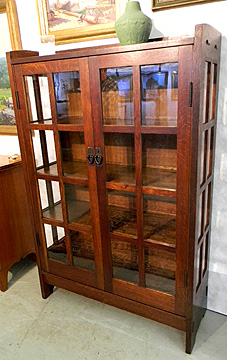
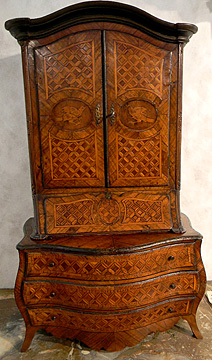
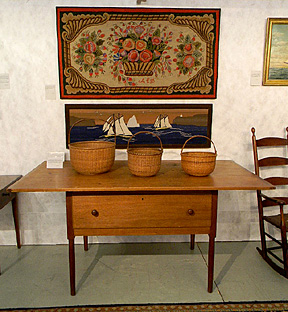 Suzanne Courcier and Robert W. Wilkins of Yarmouth Port, Massachusetts, offered this imposing Shaker worktable made in Hancock, Massachusetts, dated 1850, of pine, butternut, and cherry. The generous overhang of the pine top, classic turned legs, and original knobs are among the salient characteristics of this handsome table, which, with the exception of the finish, has survived in excellent original condition. It was 30¾" x 65¾" x 36" and $22,500. The 15½" x 50" Grenfell Mission bench cover, made in Newfoundland or Labrador in 1935 of cotton and rayon hooked on burlap, had never been used on a bench; with an original label and vibrant colors it was $4500. The exuberant floral basket design of the 1920 hooked rug from New England is wool hooked on burlap. With no repair, rebound, and professionally mounted, the 29" x 53" rug was $4500. The Nantucket basket of impressive size (13 3/8" diameter) was made of oak and rattan, dated 1900, attributed to William D. Appleton (1851-1918), and $4000. The 10" diameter Nantucket basket, made in 1880 of rattan and oak with a mahogany bottom, was $4000; and the Nantucket basket made in 1900 of rattan weavers, ash staves and handle, and a mahogany bottom, 6" high (to rim), 9½" diameter, minor loss to one rim cross wrap, was $1850.
Suzanne Courcier and Robert W. Wilkins of Yarmouth Port, Massachusetts, offered this imposing Shaker worktable made in Hancock, Massachusetts, dated 1850, of pine, butternut, and cherry. The generous overhang of the pine top, classic turned legs, and original knobs are among the salient characteristics of this handsome table, which, with the exception of the finish, has survived in excellent original condition. It was 30¾" x 65¾" x 36" and $22,500. The 15½" x 50" Grenfell Mission bench cover, made in Newfoundland or Labrador in 1935 of cotton and rayon hooked on burlap, had never been used on a bench; with an original label and vibrant colors it was $4500. The exuberant floral basket design of the 1920 hooked rug from New England is wool hooked on burlap. With no repair, rebound, and professionally mounted, the 29" x 53" rug was $4500. The Nantucket basket of impressive size (13 3/8" diameter) was made of oak and rattan, dated 1900, attributed to William D. Appleton (1851-1918), and $4000. The 10" diameter Nantucket basket, made in 1880 of rattan and oak with a mahogany bottom, was $4000; and the Nantucket basket made in 1900 of rattan weavers, ash staves and handle, and a mahogany bottom, 6" high (to rim), 9½" diameter, minor loss to one rim cross wrap, was $1850.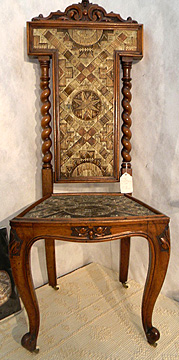 Nancy Prince of Portland, Maine, asked $5900 for the circa 1850 Micmac chair with its back and seat made of birch bark with porcupine quill decoration. This type of quilled article is a prime example of ingenuity: the artist took traditional materials (in this case quills) normally used for decorating bags and clothing decoration and fashioned a new item for the trade market. The seat cushion reflects the Victorian mode of seat cushions used in non-Native American homes of the period, possibly Nova Scotia or New England.
Nancy Prince of Portland, Maine, asked $5900 for the circa 1850 Micmac chair with its back and seat made of birch bark with porcupine quill decoration. This type of quilled article is a prime example of ingenuity: the artist took traditional materials (in this case quills) normally used for decorating bags and clothing decoration and fashioned a new item for the trade market. The seat cushion reflects the Victorian mode of seat cushions used in non-Native American homes of the period, possibly Nova Scotia or New England.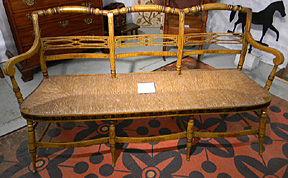 Dover House Antiques, Louisville, Kentucky, offered a Federal fancy paint-decorated settee, probably New York, circa 1820, for $9500.
Dover House Antiques, Louisville, Kentucky, offered a Federal fancy paint-decorated settee, probably New York, circa 1820, for $9500.

